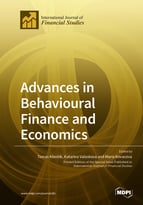Advances in Behavioural Finance and Economics
A special issue of International Journal of Financial Studies (ISSN 2227-7072).
Deadline for manuscript submissions: closed (23 October 2020) | Viewed by 61125
Special Issue Editors
Interests: financial management; behavioral finance; econometric models; credit risk
Special Issues, Collections and Topics in MDPI journals
Interests: financial markets; financial econometrics; bankruptcy prediction; credit risk
Special Issues, Collections and Topics in MDPI journals
Interests: international financial markets; behavioural decision making; risk modelling; risk analysis; financial statistics
Special Issues, Collections and Topics in MDPI journals
Special Issue Information
Dear Colleagues,
For quite a long time, financial decision-making has followed the traditional theory of finance. The traditional theory considers a given subject’s aversion to risk as an unchanging variable, and its basic principles include the fact that people choose from possible alternatives to maximize their expected profits. In 1979, Tversky and Kahneman introduced prospect theory, which states that people underweight outcomes that are merely probable in comparison with outcomes that are obtained with certainty. Further, the model considers that people generally discard components that are shared by all prospects under consideration.
Subsequently, behavioural finance theory introduced psychology behaviour science theory into finance in order to use its pioneering view to re-examine investment behaviour in financial markets. Therefore, behavioural finance holds important implications for the practice of financial management and innovation in finance and economics.
This Special Issue will publish papers related to advances in behavioural finance and economics. We are particularly interested in papers covering (1) behavioral economics and finance, (2) collaborative economics, and (3) financial markets.
We invite investigators to contribute original research articles involving theory, practice, and applications on behavioral finance and economics. All submissions must contain original unpublished work that is not being considered for publication elsewhere.
This is Special Issue is a cooperative project with Globalization and Its Socio-Economic Consequences 2019 (https://globalization.uniza.sk/)
Prof. Dr. Tomas Kliestik
Dr. Maria Kovacova
Dr. Katarina Valaskova
Guest Editors
Manuscript Submission Information
Manuscripts should be submitted online at www.mdpi.com by registering and logging in to this website. Once you are registered, click here to go to the submission form. Manuscripts can be submitted until the deadline. All submissions that pass pre-check are peer-reviewed. Accepted papers will be published continuously in the journal (as soon as accepted) and will be listed together on the special issue website. Research articles, review articles as well as short communications are invited. For planned papers, a title and short abstract (about 100 words) can be sent to the Editorial Office for announcement on this website.
Submitted manuscripts should not have been published previously, nor be under consideration for publication elsewhere (except conference proceedings papers). All manuscripts are thoroughly refereed through a single-blind peer-review process. A guide for authors and other relevant information for submission of manuscripts is available on the Instructions for Authors page. International Journal of Financial Studies is an international peer-reviewed open access quarterly journal published by MDPI.
Please visit the Instructions for Authors page before submitting a manuscript. The Article Processing Charge (APC) for publication in this open access journal is 1800 CHF (Swiss Francs). Submitted papers should be well formatted and use good English. Authors may use MDPI's English editing service prior to publication or during author revisions.
Keywords
- business economics and finance
- corporate finance and government
- accounting and taxes in the global economy
- risk management
- financial markets
- public finance management
- information systems
- collaborative digital economy, main attributes and challenges
- strategic management
- digital environment and social networks
- sharing economy business models
- business information systems








